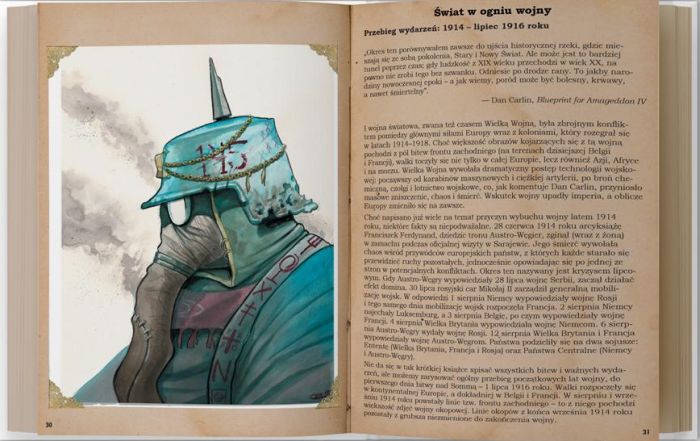If anyone is reading this, then …
You are walking on the battlefield. You try to see the remains of the hostilities. The same is everywhere, vehicle wrecks, pieces of equipment, bomb craters and the remains of wire entanglements. You look down under the weight of regret and see it, a hardcover rectangle. Yellowed sheets of paper filled with black ink and supplemented here and there with slightly lopsided drawings. This is the textbook for the role-playing game Never going home. A great procedure is the stylization of these 120 pages on war files, to which several letters from the soldiers present at the front are attached. Therefore, the booklet is devoid of sophisticated formatting, and the subtitles were limited to bold and slightly enlarged the font, but this did not adversely affect its readability. The raw and borderless content has its charm and well introduces the atmosphere that reminds me of the classic film All Quiet on the Western Front.

Source: alisgames.pl
Chaos like on the battlefield
Fragments here, whispers there, rules of combat here, introduction to the realities of the presented world there. I do not know if it is intended, but the creators of Never Going Home it was possible to introduce a confusion in the textbook comparable to the Saigon occurring on the training ground. The reason for this state of affairs is, first of all, the sequence of elements proposed by the people responsible for the composition of this book. Not knowing why it was decided to first present an exemplary fight scene and outline its rules, and only then show the skills responsible for it. The example shows that the characters can buy additional dice to increase their chances of testing. But where do they come from? What pool? Is it renewing? What are the consequences of this? Why is fortitude important in ranged combat? These and many other questions followed me over a dozen or so pages until I came across … a chapter on equipment and vehicles. Needless to say, that the information read there raised even more questions instead of answers. I do not know what the best layout of the manual is, but I think that the one that first presents the creator of characters, showing their possibilities, and only then the activities that can be performed through them, is much more optimal. The confusion is compounded by the fact that some concepts are explained a little in different parts of the manual.
You have a rifle here, and this is your sergeant
27 pages including pictures. This is what the Never going home mechanic takes. This is a sufficient dose of instructions to play a few sessions and feel the harsh climate of World War I. However, in my opinion, it is only enough for this purpose. Taking into account the mortality of the heroes, it may turn out that during one short mini-campaign you will manage to discover the entire content of the book and it will kill you wanting to read it again. I understand the latest trend, which in times when no one has time for anything, allows you to quickly prepare for the game and immerse yourself in the adventure. Only in my opinion, in most cases, it is not a matter of the thickness of the manual or the complexity of the mechanics it contains, but of the players’ approach. It seems to them that since the book is over 400 pages long, you should know the content of each page perfectly well, which is a shame. I consider, that it is much easier to give up some of the elements offered by the creators of the source material than to add the so-called houserule. I mention this because I felt a twinge of regret reading the equipment note: “As a rule, the inventory is treated abstractly. If a character has a pistol, it is assumed that they also have ammunition for it. ” In the eyes of my imagination, I saw a soldier surrounded by enemies noticing the lack of bullets in the magazine, which significantly changes its position and prompts to combine, and such an entry meant that I can throw this type of scene into the bin. Of course, any team can modify this rule and make additional provisions for resources, but we’re talking about what’s in the manual here.

Source: alisgames.pl
Doubts, interest, disappointment
This is a short summary of my impressions from the experience of Never going home. At the beginning, I was cautious about this game. I didn’t know if the adventures set in the realities of World War I were what would draw me in. It turned out that it did. The atmosphere that one feels while reading this textbook has drawn me in deeply and made me want to delve deeper into its content. Unfortunately, the poor and, however, quite complexly presented mechanics cooled my aspirations. All this meant that I will almost certainly play a campaign in this reality in the future, but for this purpose I will look for another textbook.

